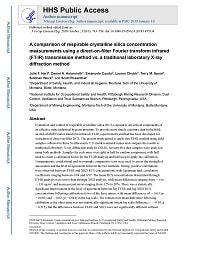Mining Publication: A Comparison of Respirable Crystalline Silica Concentration Measurements Using a Direct-on-filter Fourier Transform Infrared (FT-IR) Transmission Method vs. a Traditional Laboratory X-ray Diffraction Method
Original creation date: October 2018
Authors: JF Hart, DA Autenrieth, E Cauda, L Chubb, TM Spear, S Wock, S Rosenthal
Evaluation and control of respirable crystalline silica (RCS) exposures are critical components of an effective mine industrial hygiene program. To provide more timely exposure data in the field, an end-of-shift Fourier transform infrared (FT-IR) spectrometry method has been developed for evaluation of direct-on-filter RCS. The present study aimed to apply this FT-IR method using field samples collected in three Northwestern U.S. metal/nonmetal mines and compare the results to traditional laboratory X-ray diffraction analysis (XRD). Seventy-five dust samples were analyzed using both methods. Samples for each mine were split in half by random assignment, with half used to create a calibration factor for the FT-IR analysis and half used to apply the calibration. Nonparametric correlational and two-sample comparative tests were used to assess the strength of association and the level of agreement between the two methods. Strong, positive correlations were observed between FT-IR and XRD RCS concentrations, with Spearman rank correlation coefficients ranging between 0.84 and 0.97. The mean RCS concentrations determined through FT-IR analysis were lower than through XRD analysis, with mean differences ranging from —4 to —133 ug/m3 and mean percent errors ranging from 12% to 28%. There was a statistically significant improvement in the level of agreement between log FT-IR and log XRD RCS concentrations following calibration at two of the three mines, with mean differences of —0.03 (p = 0.002) and —0.02 (p = 0.044) in the log scale. The reduction in mean difference following calibration at the other mine was not statistically significant (mean log scale difference = —0.05, p = 0.215), but the differences between FT-IR and XRD were not significantly different without calibration (mean log scale difference = —0.07, p = 0.534). The results indicate that mine-specific calibration factors can improve the level of agreement between RCS concentrations determined via a field-based, end-of-shift FT-IR method in metal/non-metal mines as compared to traditional XRD analysis.

- Direct-on-Filter alpha-Quartz Estimation in Respirable Coal Mine Dust using Transmission Fourier Transform Infrared Spectrometry and Partial Least Squares Regression
- Direct-on-filter Analysis for Respirable Crystalline Silica Using a Portable FTIR Instrument
- Evaluating Portable Infrared Spectrometers for Measuring the Silica Content of Coal Dust
- Evaluating the Use of a Field-based Silica Monitoring Approach with Dust from Copper Mines
- Improving Silica Dust Control Through Targeted Research
- Laboratory Comparison of New High Flow Rate Respirable Size-Selective Sampler
- Reducing Silica and other Respirable Hazards in the Industrial Minerals and Metal/Nonmetal Mining Industries
- Respirable Size-Selective Sampler for End-of-Shift Quartz Measurement: Development and Performance
- Selected Publications on EVADE Software, Helmet-CAM, Dust Exposure, and Behavioral Studies
- Technology News 463 - Machine-Mounted Continuous Respirable Dust Monitor